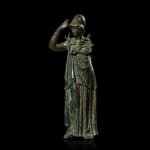Greek
Further images
Provenance
Private collection, Geneva, Switzerland, acquired before 1956
Private collection, Paris, France, acquired before 1987
Private collection, F.G., Belgium, acquired in Lyon
Christie's, London, 8 December 2021, lot 79
Literature
This bronze is a rare and important depiction of the Greek goddess Athena, dating to the Hellenistic period. The majority of surviving ancient statues of Athena tend to be Roman copies of now lost Greek originals of the Classical and Hellenistic periods. The survival of larger scale Greek bronze statuary is comparatively rare and such masterpieces as the Piraeus Athena are chance finds resulting from burial or shipwreck in antiquity. This wonderful and unique bronze captures the patron goddess of Athens with the posture, drapery, and pathos that is characteristic of the Hellenistic period.
For the type with Athena leaning her head towards her spear, see the Attic 'Pensive Athena' marble relief from the Classical Period in the Acropolis Museum in Athens (acc. no. 695), P. Demargne, 'Athena', in LIMC, vol. II, Zurich and Munich, 1984, no. 625. The form with the beltless peplos falling in heavy flowing folds, the striking Hermione Corinthian helmet, and the aegis at her chest, shows similarities with the over-life size Piraeus Athena, a Greek 4th century BC bronze original from Athens. The beltless peplos is characteristic of late Classical sculptural depictions of Athena, as well as of Artemis, for example the Dresden Artemis, (the Praxitelean Greek bronze original of circa 360-350 BC survives only in Roman copies), is also often shown thus.
Publications
Arachne Database no: 1140696 (object); 91220 (1956 photo)The bronze was photographed by Boissonnas with the image reproduced by Eva-Maria Czakó for the DAI (German Archaeological Institute Athens) in 1956 (Genf Nr. 55. 193).









